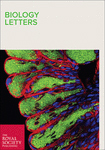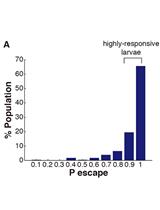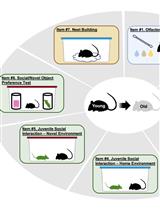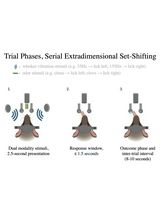- EN - English
- CN - 中文
A Behavioural Assay to Investigate Judgment Bias in Zebrafish
调查斑马鱼判断偏差的行为分析
发布: 2022年02月20日第12卷第4期 DOI: 10.21769/BioProtoc.4327 浏览次数: 3192
评审: Oneil Girish BhalalaNeloy Kumar Chakroborty Narayan Subramanian
Abstract
In this protocol, we describe for the first time a judgment bias paradigm to phenotype the way zebrafish assess ambiguous stimuli. We have developed and validated a protocol for a judgment bias test based on a Go/No-go task, and performed using a half radial maze. After a habituation phase, fish are trained to discriminate between two reference arms [positive (P) and negative (N)]. For this purpose, they experience a positive event (food reward in P), when presented with a specific location/color cue, and a negative event (chasing with net in N), when presented with a different location/color cue. Acquisition of the discrimination learning between P and N is revealed by the latencies to enter the experimental arms of the behavioral maze being significantly lower for the P arm than for the N arm. Once zebrafish are able to discriminate between P and N arms, their latency to enter other maze arms spatially located between P and N [(Near Positive (NP), Ambiguous (A) = half-way between P and N, and Near Negative (NN)] is analyzed. Latencies (L) to enter NP, A and NN maze arms are interpreted as indicating the individual expectancy to experience a reward/punishment on each of them. A judgment bias score (JBS) is calculated from the latencies to enter the P, N, and A arms for each fish [JBS = (LA–LP)*100/(LN–LP)], based on which fish can be classified into an optimistic/pessimistic axis. A JBS below 50 indicates that fish perceive the ambiguous stimulus as a positive one (optimistic bias), while JBS above 50 indicates that fish perceive the ambiguous stimulus as a negative one (pessimistic bias). However, for classification criteria, it could be advantageous to use the method of selecting extreme phenotypes (e.g., upper and lower quartiles of the JBS), since JBS in zebrafish falls into a bimodal distribution (unpublished data). Therefore, this protocol provides a unique, inexpensive, and effective alternative to other methods of measuring affective states in zebrafish that might be of great interest to a broad target audience and have a large number of applications.
Graphic abstract:
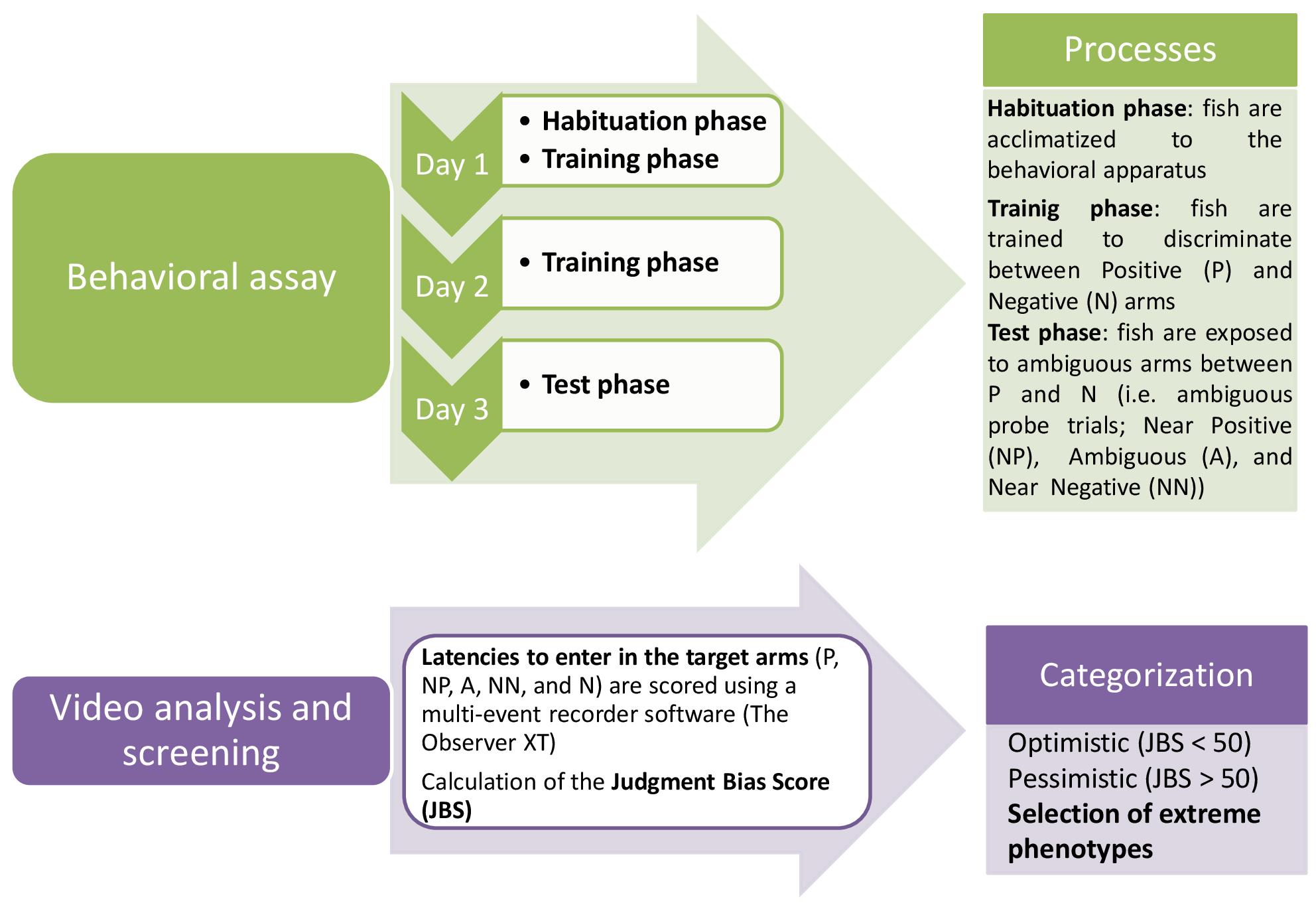
Flow chart of the judgment bias protocol in zebrafish.
Background
Zebrafish (Danio rerio) has emerged as a model organism for translational research in biomedicine, contributing to hundreds of studies on disease mechanisms, ranging from neurological and psychiatric disorders (Stewart et al., 2014), to cancer (White et al., 2013), and other age-associated diseases (Carneiro et al., 2016). Due to its robust phenotypes, and physiological (neuroanatomical, neuroendocrine, neurochemical) and genetic homologies to mammals, zebrafish has been considered as an ideal model for high-throughput behavioral assays for neurophenotyping and screening genetic mutations and psychotropic drugs. Here, we aim to describe a behavioral assay to measure judgment bias in zebrafish, in which some individuals consistently evaluate an ambiguous stimulus as negative (aka pessimists) and others as positive (aka optimists). Our assay is based on a judgment bias experimental paradigm originally developed for rodents (Harding et al., 2004), which was designed to measure expectations of positive (P) or negative (N) outcomes, when individuals are exposed to an ambiguous stimulus (A) that is intermediate between the two reference stimuli (P and N), and that they have learned to discriminate. After almost 20 years from its first publication, experimental tests to assess judgment bias have been developed and validated for a broad range of species (e.g., Mendl et al., 2010; Enkel et al., 2010; Bateson et al., 2011; Salmeto et al., 2011; Murphy et al., 2013). Most of the judgment bias studies have been focused on the effects of specific conditions inherent to life in captivity that are expected to impact the animal’s affective states. For instance, the effects of providing environmental enrichment (Douglas et al., 2012; Bethell and Koyama, 2015) and common handling procedures (Neave et al., 2013) have been broadly studied. Notably, the majority of judgment bias tasks have been shown to be very sensitive to manipulations that induce negative states (Baciadonna and McElligott, 2015). Furthermore, this behavioral paradigm has been used as a tool for assessing affective states in translational studies (Boleij et al., 2012; Rygula et al., 2015), reflecting the importance of judgment bias tests for biomedical research. However, the zebrafish have been unable to successfully perform judgment bias tasks, in large part due to their difficulties in categorizing more than one stimulus simultaneously. In fact, a number of different experimental designs based on Go/Go or Go/No-go tasks have already been tested in this species, in which the difficulties involved in selecting appropriate stimuli, balanced reward and punishment, and, importantly, in the simultaneous categorization of more than one stimulus were highlighted (Tan, 2017). Consequently, none of these assays was sufficiently reliable for judgment bias testing. In order to overcome these issues, we have used a combination of different stimulus classes (i.e., spatial and visual cues), which has been successfully operated in bumblebees (Perry et al., 2016) and may facilitate the acquisition of the relevant information for the performance of the task.
We believe the implications of the protocol reported here are of great significance for a broad variety of research fields due to its high applicability across research topics. The emerging evidence in the literature indicates that cognitive bias, and specifically judgment bias tasks, show promise as new measures of affective states in animals. Given the inaccessibility of direct reports of emotions in animals, an accurate assessment of their affective states is an important goal in animal welfare science. We also believe that this protocol is of general interest for translational scientists, with special mention of the research in psychiatric disorders, cancer, and other age-associated diseases, since it may provide an insight for inter-individual variation in susceptibility/resilience to these diseases. Considering the results of our Supporting Primary Paper (Espigares et al., 2021), we also believe that this protocol has the potential to be useful in the study of the in vivo efficacy of psychotropic drugs that have already been shown to exert a counteractive effect on telomere shortening. This is an important issue, since the correlation between the effect of telomerase activity by psychotropic medications (e.g., lithium and antidepressants) and their clinical efficacy still requires further investigation. On the other hand, a large number of psychological and neurophysiological studies suggest that judgments of ambiguous stimuli are the end result of a decision-making process that involves several components: sensory registration of the stimulus; evaluation of the stimulus and likely decision outcome; selection of a response. Therefore, the study of the cognitive and neural processes underlying judgment biases may also constitute a target for behavioral neuroscientists. Finally, our behavioral assay may have important applications in aquaculture research, since it could be easily implemented in other fish species with economic interest (e.g., sea bass, sea bream, salmon) by adapting the size of the behavioral apparatus.
Materials and Reagents
Adult zebrafish (Tübingen strain)
Acrylic dividers (Toyuto, catalog number: B07BF477K1)
Reverse osmosis purified water supplemented with 60 mg/L instant ocean sea salt (Aquariums Systems, catalog number: 210083)
Colored cards (white acrylic custom-made cards with green/red adhesive films)
Cultivated bloodworms (Ocean Nutrition, catalog number: I120E00)
Syringe 12 mL (Terumo, catalog number: SS-10S)
Airline tubing (Marina, catalog number: A1130)
Equipment
29×14×17 glass tanks (custom-made aquariums)
Half radial maze (custom-made aquarium, designed in-house; see Procedure for further details)
Camera for behavioral recording (HP, catalog number: HD 4310)
Two fish nets (Marina, catalog numbers: 11274, 11276; see Procedure for further details)
Software
Eyeline Video Surveillance System (NCH Software, version 2.06)
Observer XT (Noldus Technology, version 9)
文章信息
版权信息
© 2022 The Authors; exclusive licensee Bio-protocol LLC.
如何引用
Espigares, F., Martins, R. R. and Oliveira, R. F. (2022). A Behavioural Assay to Investigate Judgment Bias in Zebrafish. Bio-protocol 12(4): e4327. DOI: 10.21769/BioProtoc.4327.
分类
神经科学 > 行为神经科学 > 认知
生物科学
您对这篇实验方法有问题吗?
在此处发布您的问题,我们将邀请本文作者来回答。同时,我们会将您的问题发布到Bio-protocol Exchange,以便寻求社区成员的帮助。
Share
Bluesky
X
Copy link


